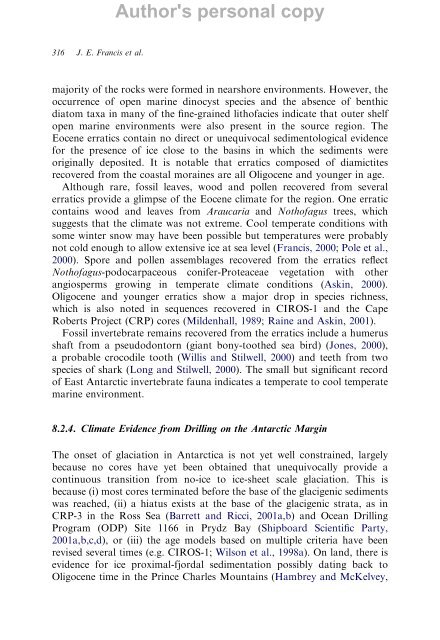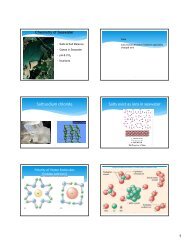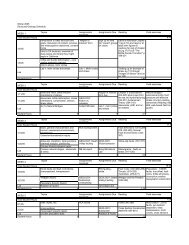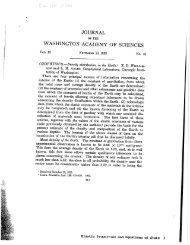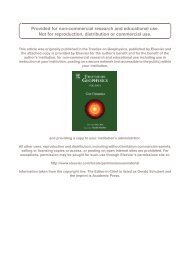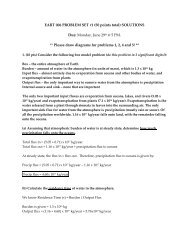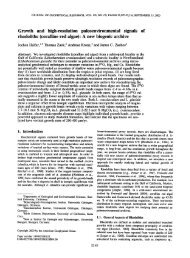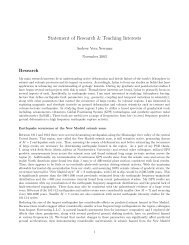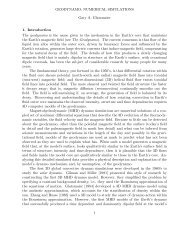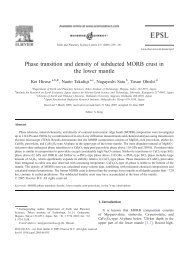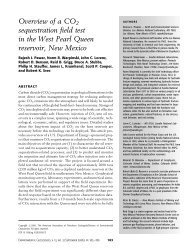From Greenhouse to Icehouse – The Eocene/Oligocene - UMass ...
From Greenhouse to Icehouse – The Eocene/Oligocene - UMass ...
From Greenhouse to Icehouse – The Eocene/Oligocene - UMass ...
Create successful ePaper yourself
Turn your PDF publications into a flip-book with our unique Google optimized e-Paper software.
316 J. E. Francis et al.<br />
Author's personal copy<br />
majority of the rocks were formed in nearshore environments. However, the<br />
occurrence of open marine dinocyst species and the absence of benthic<br />
dia<strong>to</strong>m taxa in many of the fine-grained lithofacies indicate that outer shelf<br />
open marine environments were also present in the source region. <strong>The</strong><br />
<strong>Eocene</strong> erratics contain no direct or unequivocal sedimen<strong>to</strong>logical evidence<br />
for the presence of ice close <strong>to</strong> the basins in which the sediments were<br />
originally deposited. It is notable that erratics composed of diamictites<br />
recovered from the coastal moraines are all <strong>Oligocene</strong> and younger in age.<br />
Although rare, fossil leaves, wood and pollen recovered from several<br />
erratics provide a glimpse of the <strong>Eocene</strong> climate for the region. One erratic<br />
contains wood and leaves from Araucaria and Nothofagus trees, which<br />
suggests that the climate was not extreme. Cool temperate conditions with<br />
some winter snow may have been possible but temperatures were probably<br />
not cold enough <strong>to</strong> allow extensive ice at sea level (Francis, 2000; Pole et al.,<br />
2000). Spore and pollen assemblages recovered from the erratics reflect<br />
Nothofagus-podocarpaceous conifer-Proteaceae vegetation with other<br />
angiosperms growing in temperate climate conditions (Askin, 2000).<br />
<strong>Oligocene</strong> and younger erratics show a major drop in species richness,<br />
which is also noted in sequences recovered in CIROS-1 and the Cape<br />
Roberts Project (CRP) cores (Mildenhall, 1989; Raine and Askin, 2001).<br />
Fossil invertebrate remains recovered from the erratics include a humerus<br />
shaft from a pseudodon<strong>to</strong>rn (giant bony-<strong>to</strong>othed sea bird) (Jones, 2000),<br />
a probable crocodile <strong>to</strong>oth (Willis and Stilwell, 2000) and teeth from two<br />
species of shark (Long and Stilwell, 2000). <strong>The</strong> small but significant record<br />
of East Antarctic invertebrate fauna indicates a temperate <strong>to</strong> cool temperate<br />
marine environment.<br />
8.2.4. Climate Evidence from Drilling on the Antarctic Margin<br />
<strong>The</strong> onset of glaciation in Antarctica is not yet well constrained, largely<br />
because no cores have yet been obtained that unequivocally provide a<br />
continuous transition from no-ice <strong>to</strong> ice-sheet scale glaciation. This is<br />
because (i) most cores terminated before the base of the glacigenic sediments<br />
was reached, (ii) a hiatus exists at the base of the glacigenic strata, as in<br />
CRP-3 in the Ross Sea (Barrett and Ricci, 2001a,b) and Ocean Drilling<br />
Program (ODP) Site 1166 in Prydz Bay (Shipboard Scientific Party,<br />
2001a,b,c,d), or (iii) the age models based on multiple criteria have been<br />
revised several times (e.g. CIROS-1; Wilson et al., 1998a). On land, there is<br />
evidence for ice proximal-fjordal sedimentation possibly dating back <strong>to</strong><br />
<strong>Oligocene</strong> time in the Prince Charles Mountains (Hambrey and McKelvey,


